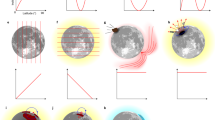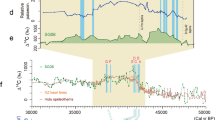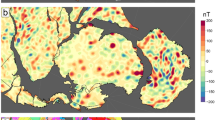Abstract
INITIAL surveys1–3 of the palaeomagnetism of the Deccan traps showed that there is an apparent decrease of palaeomagnetic inclination with altitude above sea level. This was interpreted2,4 as indicating a continuous northward movement of India during the time when the traps were being extruded. It was pointed out, however, that the observations could also be explained in terms of partial magnetic instability causing the directions to be pulled towards the present geomagnetic field. Sahasrabudhe5 has now made a very extensive palaeomagnetic study of the Deccan traps using magnetic cleaning techniques. His aim was to try to use the palaeomagnetic directions for stratigraphic purposes and he did not attempt to analyse his data for normal palaeomagnetic purposes. I have made a complete analysis of his data and the purpose of this communication is to demonstrate that the earlier results are more likely explained in terms of viscous magnetization. This conclusion leads to some consequences regarding the northward drift of India during the Tertiary.
This is a preview of subscription content, access via your institution
Access options
Subscribe to this journal
Receive 51 print issues and online access
$199.00 per year
only $3.90 per issue
Buy this article
- Purchase on Springer Link
- Instant access to full article PDF
Prices may be subject to local taxes which are calculated during checkout
Similar content being viewed by others
References
Clegg, J. A., Deutsch, E. R., and Griffiths, D. H., Phil. Mag., 1, 419 (1956).
Clegg, J. A., Deutsch, E. R., Everitt, C. W. F., and Stubbs, P. H. S., Phil. Mag., suppl., Adv. Phys., 6, 219 (1957).
Deutsch, E. R., Radhakrishnamurty, C., and Sahasrabudhe, P. W., Phil. Mag., 3, 170 (1958).
Clegg, J. A., Radhakrishnamurty, C., and Sahasrabudhe, P. W., Nature, 181, 830 (1958).
Sahasrabudhe, P. W., Semin. Geophys. Invest. Peninsular Shield, 226 (Osmania University, Hyderabad, 1963).
Verma, R. K., and Rao, A. A., Semin. Geophys. Invest. Peninsular Shield, 161 (Osmania University, Hyderabad, 1963).
Bhimasankaram, V. L. S., Geophys. J., 9, 113 (1965).
Creer, K. M., J. Geophys. Res., 67, 3461 (1962).
Gough, D. I., Opdyke, N. D., and McElhinny, M. W., J. Geophys. Res., 69, 2509 (1964).
Watson, G. S., and Irving, E., Mon. Not. Roy. Astro. Soc., suppl. Geophys., 7, 289 (1957).
Fisher, R. A., Proc. Roy. Soc., A,217, 295 (1953).
Annual Report for 1963–1964, 336, Department of Terrestrial Magnetism, Washington.
Kulp, J. L., Science, 133, 1105 (1961).
Heirtzler, J. R., Dickson, G. O., Le Pichon, X., and Pittman, W. C., Trans. Amer. Geophys. Union, 48, 133 (1967).
McElhinny, M. W., Inter. Union Geol. Sci. UNESCO Symp. Continental Drift, Montevideo, October, 1967 (in the press).
Author information
Authors and Affiliations
Rights and permissions
About this article
Cite this article
MCELHINNY, M. Northward Drift of India—Examination of Recent Palaeomagnetic Results. Nature 217, 342–344 (1968). https://doi.org/10.1038/217342a0
Received:
Revised:
Issue Date:
DOI: https://doi.org/10.1038/217342a0
This article is cited by
-
Palaeomagnetism of metadolerite dykes and sills from Proterozoic Shillong basin, NE India: Implications related to the age and magmatism
Journal of the Geological Society of India (2014)
-
Stratigraphy, composition and form of the Deccan Basalts, Western Ghats, India
Bulletin of Volcanology (1986)
-
The botanical neolithic revolution
Human Ecology (1977)
-
Chronology of Mesozoic volcanics of India
Proceedings of the Indian Academy of Sciences - Section A (1976)
-
Plate tectonic and palaeomagnetic implications for the age of the Deccan Traps and the magnetic anomaly time scale
Nature (1975)
Comments
By submitting a comment you agree to abide by our Terms and Community Guidelines. If you find something abusive or that does not comply with our terms or guidelines please flag it as inappropriate.



